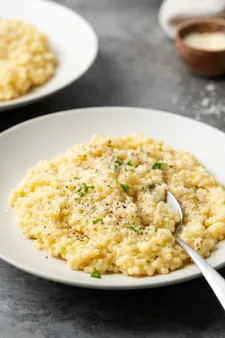Table of Contents
Embark on a culinary adventure with Tauhuichiban as we delve into The secrets of Italian pasta and risotto making. Discover the art of crafting the perfect pasta dough, the secrets of cooking pasta to perfection, and the techniques for creating mouthwatering pasta sauces. Uncover the secrets of making the perfect risotto, from selecting the finest rice to achieving the perfect creamy texture. With our guidance, you'll master the art of Italian pasta and risotto making, impressing your family and friends with authentic and delectable dishes.
The Secrets of Italian Pasta and Risotto Making for Beginners: A Culinary Delight
I. Homemade Pasta Secrets: Mastering the Art of Fresh and Flavorful Noodles
When it comes to Italian cuisine, pasta is undoubtedly one of the most iconic and beloved dishes. Whether you prefer the delicate flavors of a simple aglio e olio or the hearty richness of a ragu alla Bolognese, there's no denying the allure of a perfectly cooked plate of pasta. But what if you could elevate your pasta game and create restaurant-quality dishes in the comfort of your own home? With a few simple secrets and a little practice, you can master the art of making fresh and flavorful pasta that will impress your family and friends.
The first step in making great pasta is choosing the right ingredients. For the most authentic flavor, use high-quality Italian flour, such as "00" flour or semolina flour. These flours have a higher protein content than all-purpose flour, which will give your pasta a better texture and flavor. You'll also need eggs, salt, and water. Some recipes may also call for olive oil or other ingredients, but these are optional.
- The best Italian pasta is made with high-quality ingredients.
- Use "00" flour or semolina flour for the best texture and flavor.
- Eggs, salt, and water are the essential ingredients for pasta dough.
Once you have your ingredients, it's time to make the dough. The traditional method is to combine the flour and eggs in a bowl and knead until the dough is smooth and elastic. This can take some time and effort, but it's worth it for the best results. If you have a stand mixer, you can use the dough hook attachment to make the process easier.
Once the dough is ready, it's time to roll it out. This can be done with a rolling pin or a pasta machine. If you're using a rolling pin, be sure to dust the dough with flour to prevent it from sticking. Roll the dough out until it is thin and even, about 1/16-inch thick. If you're using a pasta machine, follow the manufacturer's instructions for rolling out the dough.
Ingredient | Amount |
"00" flour or semolina flour | 2 cups |
Eggs | 3 |
Salt | 1 teaspoon |
Water | 1/2 cup |
Once the dough is rolled out, it's time to cut it into the desired shape. You can use a knife, a pasta cutter, or a ravioli maker to create different shapes and sizes of pasta. If you're making filled pasta, such as ravioli or tortellini, you'll need to fill the pasta with your desired filling before cutting it.
The final step is to cook the pasta. Bring a large pot of salted water to a boil and add the pasta. Cook the pasta according to the package directions, or until it is al dente, which means "to the tooth." Al dente pasta is cooked through but still has a slight bite to it. Once the pasta is cooked, drain it and toss it with your favorite sauce.
Making fresh pasta at home is a rewarding experience that can be enjoyed by people of all ages. With a little practice, you'll be able to create delicious and authentic pasta dishes that will impress your family and friends. So what are you waiting for? Get started today and discover the secrets of homemade pasta!
Here are a few additional tips for making great pasta:
- Use a kitchen scale to measure your ingredients for the most accurate results.
- Knead the dough until it is smooth and elastic, but not too tough.
- Roll out the dough as thinly as possible without tearing it.
- Cook the pasta in a large pot of boiling salted water.
- Drain the pasta and toss it with your favorite sauce immediately.
With these tips, you'll be able to make delicious and authentic pasta dishes at home in no time!
Homemade Pasta Secrets: Mastering the Art of Fresh and Flavorful Noodles
II. Essential Techniques for Perfect Risotto: A Culinary Journey to Creamy Heaven
Achieving the perfect risotto is an art form that requires patience, precision, and a deep understanding of the ingredients. In this guide, we will unveil the essential techniques that will transform your risotto from ordinary to extraordinary, elevating it to a creamy masterpiece that will tantalize your taste buds.
The foundation of a great risotto lies in the careful selection of high-quality ingredients. Arborio or Carnaroli rice, known for their ability to absorb liquid and release starch, are the preferred choices for this dish. The stock used to cook the rice should be flavorful and well-seasoned, as it will impart its essence into every grain.
The toasting of the rice is a crucial step that enhances the risotto's nutty flavor and prevents it from becoming mushy. Heat the rice in a wide skillet over medium heat, stirring constantly, until it turns translucent and aromatic. This process releases the starches that will create the creamy texture of the risotto.
The gradual addition of hot stock is the key to achieving the perfect consistency. Add the stock in small increments, stirring constantly to allow the rice to absorb the liquid and release its starches. This slow and steady process ensures that the risotto cooks evenly and develops a rich, velvety texture.
The stirring technique is equally important. Use a wooden spoon or spatula to gently stir the risotto in a circular motion. This constant stirring prevents the rice from sticking to the pan and promotes the release of starches, creating the desired creaminess.
The cooking time of risotto varies depending on the type of rice used and the desired consistency. Arborio rice typically takes about 18-20 minutes to cook, while Carnaroli rice may require a few minutes longer. Taste the rice frequently to determine if it is al dente, with a slight bite to it.
Once the risotto is cooked, it is important to let it rest for a few minutes before serving. This allows the rice to absorb any remaining liquid and develop its full flavor. During this resting period, you can stir in additional ingredients such as cheese, vegetables, or meat to enhance the flavor profile.
Mastering the art of risotto cooking requires practice and patience, but the rewards are well worth the effort. By following these essential techniques, you can create a creamy, flavorful risotto that will impress your family and friends, leaving them craving for more.
Essential Techniques for Perfect Risotto |
|---|
Toasting the rice |
Gradual addition of hot stock |
Constant stirring |
Cooking to the desired consistency |
Letting the risotto rest before serving |
Here are some additional tips for achieving risotto perfection:
- Use a wide skillet or saucepan to allow for even cooking and prevent the rice from sticking.
- Do not overcook the risotto, as it will become mushy.
- If the risotto becomes too thick, add a little more hot stock or water.
- If the risotto becomes too thin, cook it for a few minutes longer or add a little more rice.
- Experiment with different flavors by adding your favorite ingredients, such as cheese, vegetables, or meat.
With these techniques and tips, you can create a creamy, flavorful risotto that will become a staple in your culinary repertoire. So gather your ingredients, put on your apron, and embark on a culinary journey to risotto perfection!
Related posts:
- The Secrets of Italian Pasta and Risotto Making
- The Art and Science of Making the Perfect Risotto
- The Secrets of Cooking Risotto to Perfection
Essential Techniques for Perfect Risotto: A Culinary Journey to Creamy Heaven
III. Mastering the Art of the "Perfetto" Pasta Sauce
In Italian cuisine, the preparation of a flavorful and authentic pasta sauce is an art form that requires patience, skill, and an understanding of the delicate balance of flavors. While there are countless variations of pasta sauces, the fundamental principles remain the same: using the freshest ingredients, combining them in the right proportions, and allowing the sauce to simmer until its flavors have fully developed.In this comprehensive guide, we will delve into the secrets of creating the perfect pasta sauce, exploring the essential ingredients, techniques, and tips to elevate your pasta dishes to culinary masterpieces. Whether you're a seasoned chef or a home cook yearning to impress your loved ones, this guide will empower you with the knowledge and techniques to create authentic and tantalizing pasta sauces that will delight your taste buds and leave you craving for more.
. Unlock the secrets of Italian pasta and risotto
Mastering the Art of the "Perfetto" Pasta Sauce
IV. The Secrets of Cooking Authentic Italian Risotto: Techniques and Tips
- <
- Use the right rice: Arborio, Carnaroli, or Vialone Nano.
- Toast the rice in olive oil before adding the liquid.
- Add the liquid gradually, stirring constantly.
- Cook the risotto until it is creamy and al dente.
- Stir in grated Parmesan cheese and butter at the end.
Ingredient | Amount |
|---|---|
Arborio rice | 1 cup |
Olive oil | 2 tablespoons |
Onion | 1/2 cup, chopped |
Garlic | 2 cloves, minced |
Dry white wine | 1/2 cup |
Chicken broth | 3 cups |
Grated Parmesan cheese | 1/2 cup |
Butter | 2 tablespoons |
Risotto is a classic Italian dish that can be made with a variety of ingredients. The most important thing is to use the right rice and to cook it slowly and carefully. With a little practice, you can make a delicious and authentic risotto at home.
Here are some tips for cooking risotto:
- Use a heavy-bottomed pot so that the rice doesn't stick or burn.
- Stir the risotto constantly to prevent it from sticking.
- Don't add too much liquid at once. Add it gradually, stirring constantly, and only add more when the rice has absorbed the previous liquid.
- Cook the risotto until it is creamy and al dente. It should have a slight bite to it.
- Stir in grated Parmesan cheese and butter at the end to give it a rich and creamy flavor.
Risotto is a versatile dish that can be served with a variety of toppings. Some popular toppings include grilled chicken, shrimp, or vegetables. You can also add herbs and spices to taste.
The Secrets of Cooking Authentic Italian Risotto: Techniques and Tips
V. Conclusion
Through this comprehensive guide, we have unveiled the secrets of Italian pasta and risotto making, empowering you to create authentic and delectable dishes that will impress your family and friends. Remember, practice makes perfect, so don't be afraid to experiment with different ingredients and techniques to find what works best for you. With patience and dedication, you will master the art of Italian pasta and risotto making, bringing the flavors of Italy to your own kitchen. Buon appetito!